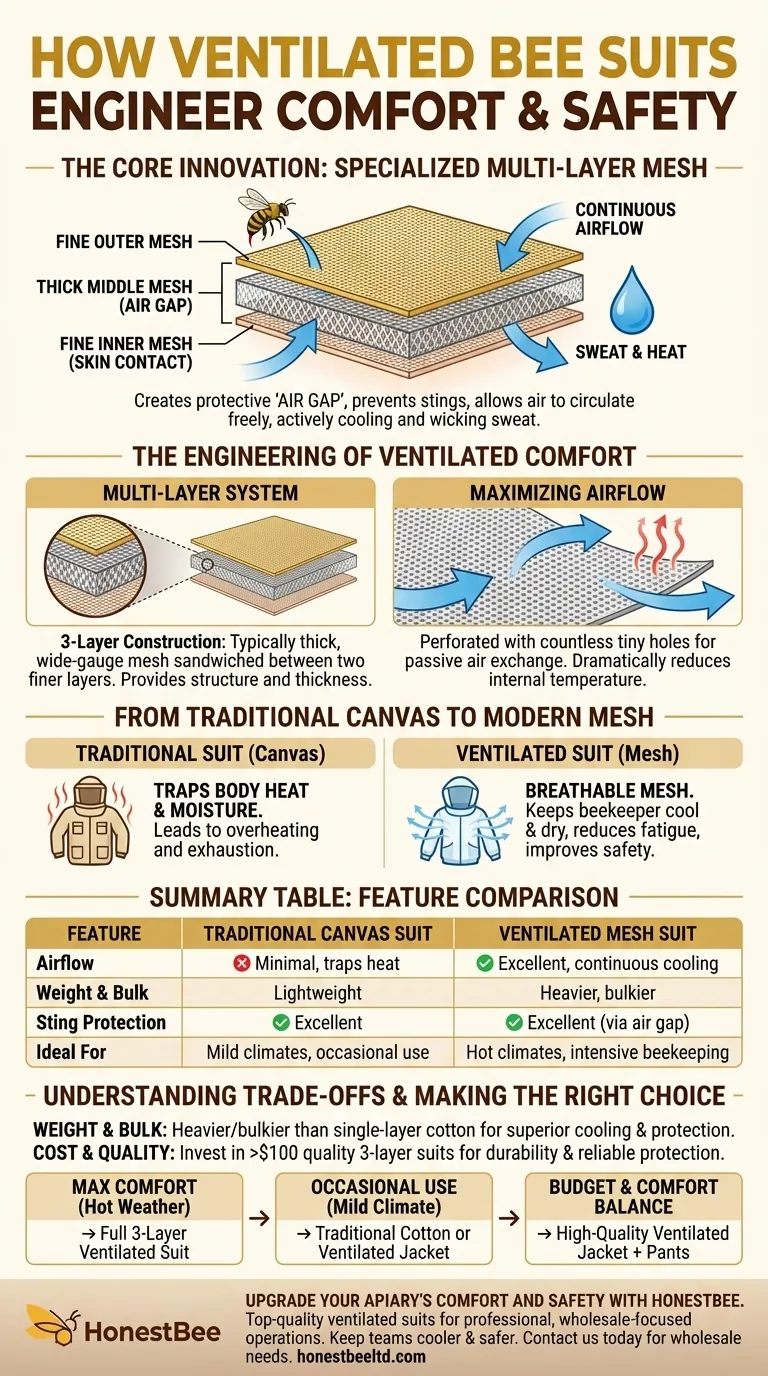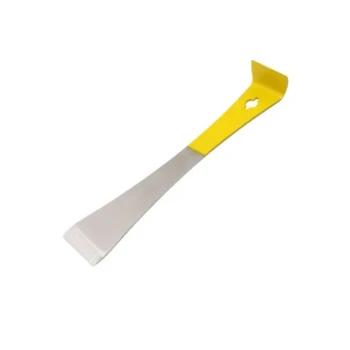At their core, ventilated bee suits improve comfort by using a specialized multi-layer mesh fabric. This design allows for continuous airflow directly to your body, actively cooling you and wicking away sweat in a way traditional canvas or cotton suits simply cannot.
The central innovation is not just the material, but its structure. Ventilated suits create a protective "air gap" between you and the bees, using the thickness of the layered mesh to prevent stings while allowing air to circulate freely.

The Engineering of Ventilated Comfort
To understand the value of a ventilated suit, you must first understand its specific design. It's an engineered solution that solves the dual problem of sting protection and heat management.
The Multi-Layer Mesh System
Most high-quality ventilated suits are constructed from three distinct layers of mesh. Typically, this involves a thick, wide-gauge mesh sandwiched between two layers of finer mesh.
This multi-layer approach is critical. It provides the necessary structure and thickness to function effectively as protective gear.
Creating an Air Gap for Protection
The combined thickness of the mesh layers is the key to sting prevention. It creates a significant gap between the outer surface of the suit and your skin.
A bee's stinger is simply not long enough to bridge this gap, meaning you remain protected even without the dense, suffocating fabric of a traditional suit.
Maximizing Airflow
Unlike solid cotton or canvas, the mesh fabric is perforated with countless tiny holes. This allows outside air to flow in and body heat to escape.
This constant, passive air exchange dramatically reduces the internal temperature of the suit, making long hours in the sun far more tolerable.
From Traditional Canvas to Modern Mesh
The shift to ventilated suits represents a significant leap forward in beekeeping equipment, directly addressing the biggest comfort complaint of the past.
The Problem with Traditional Suits
Classic beekeeping suits are made from thick cotton canvas. While effective at stopping stings, they are also incredibly hot.
They trap body heat and moisture, quickly leading to overheating and exhaustion, especially during strenuous work in warm climates.
The Ventilated Suit Advantage
Ventilated suits solve this problem directly. The breathable mesh offers a superior balance between safety and comfort.
By keeping the beekeeper cool and dry, these suits reduce fatigue and make the entire experience safer and more enjoyable.
Understanding the Trade-offs
While ventilated suits offer superior comfort, it is essential to approach them with a clear understanding of their characteristics. They are a specific tool with their own set of considerations.
Weight and Bulk
The multi-layer mesh construction, while breathable, often makes a ventilated suit heavier and bulkier than a simple, single-layer cotton suit.
This is a direct trade-off: you are exchanging the lightweight nature of cotton for the superior cooling and sting protection of the layered mesh.
Cost and Quality Considerations
Quality is paramount. A well-made, 3-layer ventilated suit is a durable piece of protective equipment.
Be wary of suits that cost less than $100. Lower-cost options may use inferior materials that offer less reliable protection and will not hold up over time. Think of a quality suit as an investment in your safety and comfort.
Making the Right Choice for Your Goal
Selecting the right suit depends on your climate, the intensity of your beekeeping, and your budget.
- If your primary focus is maximum comfort in hot weather: A full, 3-layer ventilated suit is the definitive choice and a worthwhile investment.
- If your primary focus is occasional use in a mild climate: A traditional cotton suit or a ventilated jacket may be sufficient, but always prioritize quality construction.
- If your primary focus is balancing budget and comfort: Consider a high-quality ventilated jacket paired with separate pants, but do not compromise on the quality of the protective mesh.
Ultimately, choosing the right equipment empowers you to focus on the health of your bees, not your own discomfort.
Summary Table:
| Feature | Traditional Canvas Suit | Ventilated Mesh Suit |
|---|---|---|
| Airflow | Minimal, traps heat | Excellent, continuous cooling |
| Weight & Bulk | Lightweight | Heavier, bulkier |
| Sting Protection | Excellent | Excellent (via air gap) |
| Ideal For | Mild climates, occasional use | Hot climates, intensive beekeeping |
Upgrade Your Apiary's Comfort and Safety with HONESTBEE
Are you a commercial apiary or equipment distributor looking to improve productivity and safety for your team? The right protective gear is a critical investment. HONESTBEE supplies top-quality, durable ventilated bee suits and a full range of beekeeping equipment designed for professional, wholesale-focused operations.
We understand the demands of large-scale beekeeping. Our gear helps keep your teams cooler, safer, and more focused on hive management.
Ready to equip your operation with the best? Contact HONESTBEE today to discuss your wholesale needs and discover how our equipment can enhance your bottom line.
Visual Guide

Related Products
- Cotton Beekeeping Suit and Round Hat with Veil Bee Keeper Protective Gear
- White Beekeeping Protective Suit and Hat with Fencing Veil for Beekeepers
- Beekeeper Cowboy Hat and Veil for Beekeeping
- Heavy Duty Cowboy Beekeeper Hat with Visibility Veil Outdoor Professional Beekeeping Protective Gear
- Mesh Ventilated 3 Layer Goatskin Beekeepers Gloves for Beekeeping
People Also Ask
- What is recommended for beginners in beekeeping regarding protective clothing? A Complete Safety Guide for New Beekeepers
- How should a beekeeping suit be hung to maintain its shape? Protect Your Investment with Proper Storage
- Do beekeeping suits completely prevent stings? Maximize Your Apiary Safety with the Right Gear
- What factors should be considered when choosing a beekeeping suit? Balance Safety, Comfort & Performance
- What are the benefits of a fully ventilated beekeeping suit? Stay Cool and Protected in Hot Climates



















